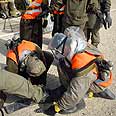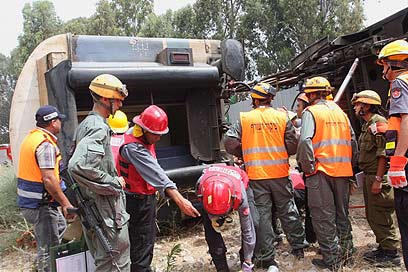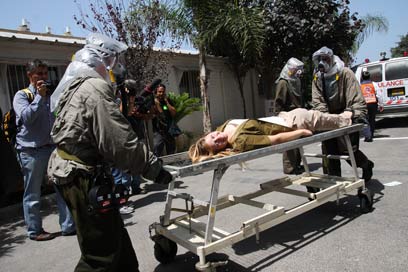
2nd Lebanon War x7
Tons of explosives rain on Tel Aviv, refugees flee the cities, a population panicky, hospitals overwhelmed – last week IDF drilled according to frightening scenario
The headline of the newspaper Tafnit Bahadashot, in white letters on a red background, was alarming: "First chemical attack on Israel – dozens dead, hundreds injured."
The article went on to say that Soroka University Medical Center in Beersheba was overwhelmed by the pressure and even those who weren't injured were under severe shock. The following day the paper reported on five missiles that fell almost simultaneously on Tel Aviv, whose residents took themselves abroad or to tent cities.
These special editions weren't seen by the general public. Only certain people who took part in the Home Front exercise "Turning Point 4" got to see them. The writers and editors of the paper, as well as the writers of the fictitious website, were the exercise's directors in an attempt to imagine the public and media chaos that would erupt if their horrendous scenarios were to develop.
While most people are keeping their eyes on developments in Iran, the security forces turned their attention to the octopus' other tentacles – missiles and rockets in the immediate vicinity. These, with logistic support, training and instruction in the field, make Syria, southern Lebanon and the Gaza Strip far more threatening – closer, in terms of time and geographic distance, than the potential nuclear threat from Iran.
"What we saw this week was not just for show or some imaginary scenario," said a security source who had taken part in the extensive drill. "We may certainly have to cope with such an attack that we have never experienced before, particularly on the home front."

An 'overturned train' (Photo: George Ginsberg)
The drill's clock began ticking on the 15th day of fighting. Two weeks earlier, a fictitious "senior Hezbollah figure" was assassinated, which led to an almost immediate deterioration on all fronts, particularly in the north. The next clash could indeed develop in this way – only one small spark is required to set off a major conflagration. This week the IDF's offensive capabilities were not addressed – not even missile interception capabilities.
Of course the IDF will use all capabilities to reduce the number of victims, but one glance at the newspaper is enough to understand what will happen here: Three subheadings describe the chaos, the flight from the cities, and the temporary closure of the international airport due to serious damage to the runways. More than 200 tons of explosives were fired at Israel in the exercise, nearly three times the quantity fired in the summer of 2006.
Escalation in the next round of violence is dependent on the other side too: A war on three fronts, which was the scenario for the drill, would result in hundreds of deaths on the home front and unprecedented chaos. The tension will make population management extremely difficult. Black body bags in mass graves – such images cannot be passed over easily.
Missiles will empty the greater Tel Aviv area (Gush Dan), destroy major traffic arteries, and lead to a shortage of basic necessities in the periphery which will have to cope with refugees, leading to complete social collapse. Hospitals will not cope with the numbers of wounded, many will be dependent on aid organizations and volunteers whose numbers will go down as the situation continues, the education system will collapse, banks will struggle to function. And we haven’t mentioned strategic installations, some containing dangerous materials.
In short: A frightened and paralyzed society, with feelings of frustration and despair projected from the home front to the battlefront.
Great unknown: Population behavior
Whether a war breaks out next summer or not, Israel faces an enormous challenge. "Turning Point" was intended mainly to drill the command chains, systems and organizations to deal with hundreds of thousands of refugees, rescue victims from beneath collapsed hospitals, evacuate pensioners, clear areas of chemicals, and – at the same time – to know how to operate a special television studio under the Home Front command, and control messages to the population as much as possible.
Even the operation of some 2,600 sirens on Wednesday had a purpose in checking the preparedness of the system. Of less significance was the number of citizens who gave up ten minutes of their time to get inside shelters. Next year the drill will be carried out in the evening, as a way of increasing awareness.
By then, the Home Front is expected to have completed new preparations for warnings against missiles bearing non-conventional warheads, which will be different from the oscillating siren heard last week.

IDF officers who know the field well said that in addition to the important drills and preparations, there is still one great unknown: The population's behavior. And on this subject, it seems citizens are unsure what is expected of them.
"We can envision a scenario like a Lebanon war three or four times greater than the last Lebanon war, and if Syria joins, then six or seven times greater. And as if that wasn't enough, Hamas and organizations in Gaza can also take part," one officer tried to sum up the threats.
The IDF is familiar with public opinion, according to which war is not some imaginary scenario, but still people are not aware of the possible extend of a war (as the stock exchange and real estate markets testify). The drill scenario is likely to be seen as an exaggeration.
"Just this week we heard people speaking against what may be expected here," one officer said. "Many think that if there's a war, it'll be a rerun of the Lebanon war, or something like that."
But things are a little different, according to those in the know who are coping with the usual dilemma: The fear of creating panic alongside the need to prepare the population.
Yet despite the extreme scenarios, the security services are also trying to keep things calm. The processes undergone by the Home Front during the last three years will moderate all the scenarios described here.
"Though it may not stop a missile, we will know how to deal with such a situation and reduce the number of losses," an officer said. "If people leave one city for another, we'll be there and know how to set up the place for this scenario. Basically, we need to get better and be there for the people."










